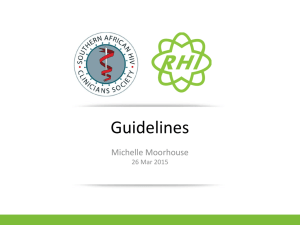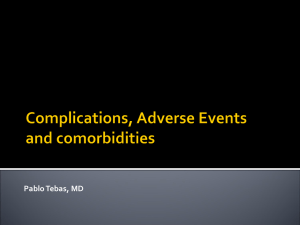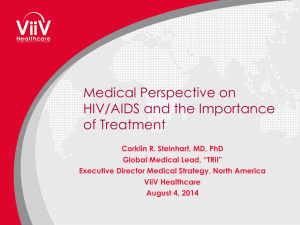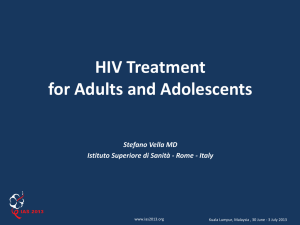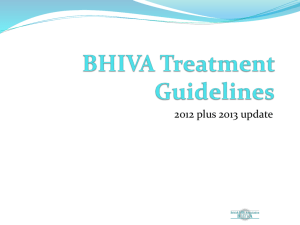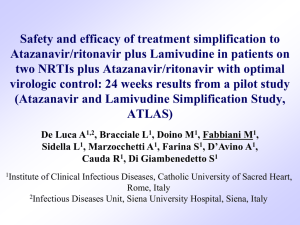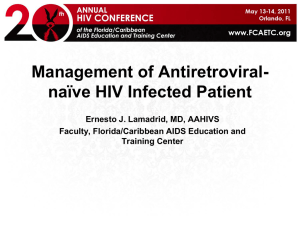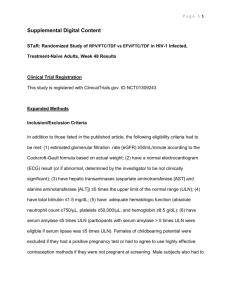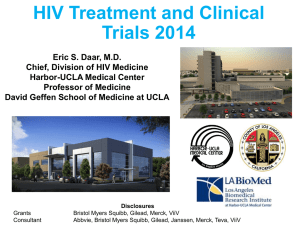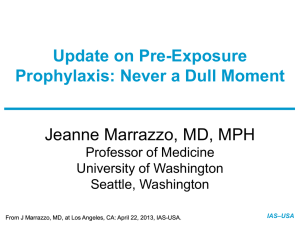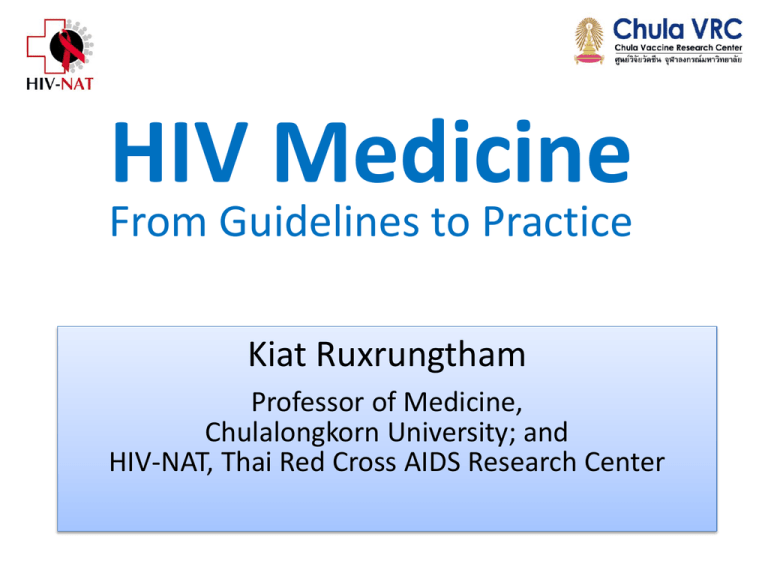
HIV Medicine
From Guidelines to Practice
Kiat Ruxrungtham
Professor of Medicine,
Chulalongkorn University; and
HIV-NAT, Thai Red Cross AIDS Research Center
Three Decades of HIV/AIDS
Learning and the Future
Evidences and developments
One/ two ARVs
Improve survival
1981
late 1980
Few ARVs
More toxicity
Three ARVs
(HAART)
Durable
undetectable VL
Earlier HAART
non-AIDS death
Transmission
New TB
Mid 1990
More class ARVs
More potent –PIs
But high pill burden
2012 - 2014
More new ARVs
More tolerable
More OD options
More FDC options
Single tablet regimens
Availability and treatment options
New strategies
Long-acting ARV ?
Cure ?
2020
Monthly ARV?
Cure ?
HIV/AIDS in Thailand
MSM
10-30%
Natural History of HIV Disease Progression
Median time to progress
90%
HIV
Infection
<10%
<1%
Typical Progressors
7-12 yrs
Rapid Progressors
<3 yrs
Long-term
Non-progressors
>15 yrs
Normal, Stable CD4+ T cell count
Viral load <500 copies/ml
CD4 cell count
500 ? START trial
Clinical outcomes
No AIDS-complication +
No non-AIDS-complication
350
CIPRA
HT001
200
Years After HIV Infection
Current Update on
HIV Treatment 2014
When to start ART by guidelines
Guidelines
CD4
U.S. DHHS 2014
All
WHO 2013
<500
Thai 2014
All
Note
When the patient is ready and
committed to treatment
Regardless of CD4 for specific
settings and the patient is ready
and committed
When the patient is ready and
committed to treatment
HIV Late Presentation
Remains a major challenge worldwide
UK
USA
30-50%
CD4 <200
60-70%
CD4 <350
Latino, Black
Thailand
Nigeria
50%
CD4 <200
1J
India
50%
CD4 <200
40%
CD4 <50
Int AIDS Soc. 2010; 13(Suppl 4): P107; 2Clin Infect Dis. 2011 Sep;53(5):480-7; 3Interdisciplinary
Perspectives on Infect Dis 2012; 4Afr J Health Sci. 2007; 14:212-215; 5 Curr HIV Res. 2009 May;7(3):340-5
Incidence of IRIS Following HAART
IRIS
HIV
Coinfection
10-15 % in N. America and Europe
20-25 % in resource-limited countries
Bonham et al. Biomarker Medicine 2008; 2:349-361
Murdoch et al. AIDS Res Therapy 2007; 4:9
Timing of IRIS
Viral load
IRIS
Risk Factors
• Low BL CD4 count
• Rapid decline of VL
• Early timing of HAART
following OI Rx
CD4
Weeks
Months
Years
Time Following HAART
Photo is from -Dhasmana et al. Drugs 2008; 68 (2): 191-208
When to start ART in patients with OIs
Type of OI
Tuberculosis
CD4 (cell/mm3)
≤ 50
>50
within 2
weeks
Severe
Not-severe
Cryptococcosis
within 2 between 2-8
weeks
weeks
between 4-6 weeks
PCP, MAC, others
between 2-4 weeks
CMV, PML,
Cryptosporidium
as soon as possible
Thai Guidelines 2014
Current Antiretroviral Agents
RT Inhibitors
Protease Inhibitors
NRTI: AZT, ABC, ddI,, d4T, 3TC, , FTC,
NNRTI: NVP, EFV, ETV, RPV
SQV, rtv, IDV, NFV, AMV, LPV/rtv, ATV, fAMP, DRV
6
ds DNA
NTRTI: Tenofovir (TDF)
Genomic RNA
vpr
HIV
DNA
1
2
3 Integrase
Proviral DNA
5
Protease
RT
RNA
Transcription
4
mRNA
Entry Inhibitors
Spliced mRNA
Polyprotein
Protein
CCR5 inhbitor: Maraviroc (MVC)
Integrase inhibitors
Fusion gp41: Enfuvirtide
Raltregavir (RAL)
Elvitegravir
Dolutegravir
Currently Available Antiretroviral Agents 2014
in Developed Countries (Available =30)
NRTI =8
NNRTI =5
Nucleos(t)ide RTIs
Non-nucleoside RTIs
1.
2.
3.
4.
5.
6.
7.
8.
1.
2.
3.
4.
5.
Zidovudine (ZDV)
Didanosine (ddI)
Zalcitabine (ddC)
Stavudine (d4T)
Lamivudine (3TC)
Abacavir (ABC)
Emtricitabine (FTC)
Tenofovir DF (TDF)
EI=2
Fusion Inhibitor
• Enfuvirtide (T-20)
CCR5 Antagonist
• Maraviroc (MVC)
Nevirapine (NVP)
Delavirdine (DLV)
Efavirenz (EFV)
Etravirine (ETR)
Rilpivirine (RPV)
Integrase inh =3
Integrase Inhibitors
• Raltegravir (RAL)
• Dolutegravir
• Elvitegravir
PI =10
Protease Inhibitors
1. Saquinavir (SQV)
2. Ritonavir (RTV)
3. Indinavir (IDV)
4. Nelfinavir (NFV)
5. Amprenavir (APV)
6. Lopinavir/r (LPV/r)
7. Atazanavir (ATV)
8. Fosamprenavir (fAPV)
9. Tipranavir (TPV)
10. Darunavir (DRV)
EI=2
Boosters
• Ritonavir (RTV)
• Cobicistat* (cobi)
Currently Use Antiretroviral Agents 2014
in Developed Countries (current use=17)
PI =3
NRTI =5
NNRTI =4
Nucleos(t)ide RTIs
Non-nucleoside RTIs
Protease Inhibitors
1.
2.
3.
4.
5.
1.
2.
3.
4.
1. Lopinavir/r (LPV/r)
2. Atazanavir (ATV)
3. Darunavir (DRV)
Zidovudine (ZDV)
Lamivudine (3TC)
Abacavir (ABC)
Emtricitabine (FTC)
Tenofovir DF (TDF)
EI=1
CCR5 Antagonist
1. Maraviroc (MVC)
EI= entry inhibitor
II = integrase inhibitor
Efavirenz (EFV)
Etravirine (ETR)
Rilpivirine (RPV)
Nevirapine (NVP)
II =2
Integrase Inhibitors
1. Raltegravir (RAL)
2. Dolutegravir
3. Elvitegravir
Booster = 2
Boosters
1. Ritonavir (RTV)
2. Cobicistat (cobi)
What to start in Resource-rich settings?
Three drug combination in Naïve Patients
2 Nucleoside RT Inhibitors + NNRTI or Boosted PI or Integrase inhibitor
NtRTI or
NRTI
NRTI Cytidine
Analog
NNRTI or
bPI or Integrase inh.
TDF
ABC*
FTC
3TC
Efavirenz
Atazanavir/r
Darunaivr/r
Raltegravir
Dolutegravir
Evitegravir/cobi1
Rilpivirine2
++
AZT
*if HLA B*5701 is negative
Remarks
FDC –single table available:
Dual NRTI:TDF/FTC, ABC/3TC
Triple: TDF/FTC/EFV, TDF/FTC/RPV
U.S. DHHS Guidelines May 2104
++
1eGFR>70; 2when
VL<100,000 c/ml
Considerations When Selecting Firstline Antiretroviral Therapy
Patient/Viral Factors
Antiretroviral Drug Factors
Baseline CD4+ cell count/
HIV-1 RNA level
Efficacy
Age
Tolerability
Sex
Long-term toxicity/metabolic
effects
Occupation (eg, work schedule)
Baseline drug resistance
Comorbid conditions (eg, CV risk,
renal abnormalities)
Drug–drug interactions
Plans for pregnancy
Pill burden
Access to care
Pharmacokinetics
Concurrent medications
Cost
Dosing frequency
Adherence to other medications
Genetics (eg, HLA-B*5701)
Viral tropism
Kuritzkes D et al. www.clinicaloptions.com
Individualizing First-line Therapy
Circumstance
Agents
No genotype
Use boosted PI
High HIV-1 RNA
Caution with ABC, RPV
Renal disease
Caution with TDF, ATV/RTV; monitoring
complicated with COBI and DTG
Dyslipidemia
RAL, DTG, RPV most lipid neutral
CV risk factors
Possible association with ABC, ddI, LPV/RTV
No data for DRV/RTV, INSTIs, MVC
Pregnancy
Preferred: ZDV/3TC + NVP, LPV/RTV, or ATV/RTV
EFV can be used after first 5-6 wks
Chronic HBV infection
Preferred TDF + 3TC or FTC
Alternative is entecavir
Decreased BMD
Caution with TDF
Concerns on CNS effects
Caution with EFV for at least first mo
Kiriztkes D et al. www.clinicaloptions.com
Current Strategy and Trend
Prescribing a Simplify regimen
Once-daily
Single tablet regimen (STR)
Atripla® (TDF/FTC/EFV)
Complera® (TDF/FTC/RPV)
Download New AIDS Guidelines 2014
www.aidsstithai.org/
contents/view/60
Baselines and FU Lab tests
What to start in Resource-limited settings?
Three drug combination in Naïve Patients
2 Nucleoside RT Inhibitors + NNRTI or Boosted PIs
NtRTI or
NRTI
TDF
ABC
AZT
+
Cytidine
Analog
+
3TC
FTC
d4T
NNRTI or
Boosted PIs
+
EFV
+
RPV
NVP
Alternative
LPV/r
Thai Guidelines 2014
ATV/r
Adherence is critical
Potential Concern When Stopping Drugs With Different T1/2
Day 1
Drug Concentration
Last Dose
Day 2-weeks
AZT
NNRTI (EFV, NVP, RPV)
3TC
MONOTHERAPY
IC90
Zone of potential replication
0
12
S. Taylor et al. 11th CROI Abs 131
24
Time (Hours)
IC50
36
48
EFV: Standard doses of Efavirenz associated
with a higher exposure in Thais/Asians
3
Std dose 600 mg/day
Median AUC (h*mmg/L)
3
2.5
2.2
2.1
2
1.5
1
0.5
0
Caucasian Std
dose
Asian Std dose
Asian Lower
Dose
Ethnic and dosing
van der Lugt J, and Avinhingsanon A. Asian Biomedicine Feb 2009
Lower dose 400 mg/day
A Lady with Very Severe CNS side-effect –couldn’t work
and about to give-up her EFV-based HAART
EFV –severe CNS AEs with poor QoL
EFV level 21.39
mg/L
At EFV 600 mg qd
EFV level 4.5-5.2
mg/L
At EFV 300 mg qd
currently she is happy with this regimen
and has VL<50 for >2 yrs
กรณี ถือศีลอด
How to detect failure and DR?
Time-course of HAART Failure
Thai NHSO guidelines:
VL q 6 mo, until VL<50, then q 1 yr
CD4: q 6 mo, until CD4 >350, q 1 yr
Resistance
CD4 drop
Viral load
NonAdherence
Clinical
1
Started HAART
2
3
4
Time (months –years)
5
Viral Load and CD4 Tests
Virologic Failure
“The inability to achieve or maintain suppression of viral replication”
Setting
Incomplete
suppression
after 24
weeks
Virologic
Rebound
DHHS 2009
>400*
DHHS 2011
>200*
WHO 2009
>5000**
>50
>200***
>5000
*High Baseline VL (>100,000 c/ml) may take longer than low BL VL
**Values of >5 000 copies/ml are associated with clinical progression and a decline in the CD4 cell count
***>200 is associated with evidence of viral evolution and drug-resistance mutation accumulation
Second-line ART controlled studies
Study
N
comparators
HIV-STAR
200
TDF/3TC +LPV/r
LPV/r mono
SECONDLINE
550
2NRTI +LPV/r
RAL +LPV/r
ALISA
386
TDF/FTC +LPV/r
TDF/3TC +ATV/r
2LADY
450
EARNEST 1277
TDF/FTC +LPV/r
ABC/ddI +LPV/r
TDF/FTC +DRV/r
2NRTIs +LPV/r
RAL +LPV/r
LPV/r mono
www.clinicaltrials.gov (assessed 22 Apr 2012)
Sites
Thailand
10 sites
Sponsors
HIVNAT,
Nov 2011
NHSO, Swiss
cohort
All
Kirby
continents Insitute,
18 countries Australia
Africa
End point
analysis
Sept 2012
French NIH
May 2013
ANRS12169
Sep 2013
SA, Tanzania
Africa
Burkina Faso,
Cammaroon,
Senegal
Africa
5 countries
MRC, EDCTP Dec 2013
HIV-STAR Results
% patients with plasma HIV-1 < 50 c/ml
(HIVNAT, TRC-ARC, Thailand initiated trial)
Patients with baseline GSS≥ 2 had a better % with VL< 50 c/ml
at 48 weeks of treatment
100
*P<0.05
80
60
79
83.3 *
61
40
20
0
Mono LPV/r
GSS 1
GSS 2
TDF/FTC/LPV/r arm
Number of active NNRTI(s) in the regimen
No. of subjects = 98
19
Bunupuradah T , et al,. Antiviral therapy 2012 Jul 2. doi: 10.3851
78
SECOND-LINE results
SECOND-LINE Study
% patients with VL<200 c/ml
Patients failed NNRTI-regimens
RAL/LPV/r
83%
81%
NRTIs/LPV/r
N= 270
N= 271
Pros:
1. Not required DR test
2. Easy for trained nonmedical staffs to
deliver care (task
shifting)
3. Easy for drug supply
and stock
4. RAL is less toxicity
than NRTS
Cons: RAL is expensive
Lancet 2013, June 15; 381: 2091–99
Options after First-line Failure
NRTI in the
NRTI option
failing regimen
TDF failure
Guided by resistance
test results, or
Consider : AZT/3TC
AZT or ABC
failure
Guided by resistance
test results, or
Consider :TDF/FTC or
TDF/3TC
Third ARV option
Preferred :
Lopinavir/ritonavir
(LPV/r)*
Alternative:
Atazanavir/ritonavir
(ATV/r),
darunavir/ritonavir
(DRV/r)
boosted PI : WARNING
Serious Drug Interaction
1. Ergotism: ergotamine
2. Rhadomyolysis: statins (simvastatin, etc.) Alternatives:
pravastatin, fluvastatin and fibrate derivatives
3. Excessive sedation: benzodiazeoines (diazepam,
alprazolam, midazolam,..)except lorazepam
4. Hypotension: Ca-blockers (amlodipine, nifedipine,
felopdipine), beta-blockers
5. Cushing syndrome, adrenal insufficiency: with fluticasone
6. Torsades de Pointes (prolong QT and ventricular
arrhythmia): cisapride, pimozide; ditiazem;
antiarrhythmic –flecanide, amiodarone, quinidine etc.
Ergotism and bPI is not common
in patients who were well VL control and on bPIs
bPI –Ergotamine AEs
Thai report
N=23
All had VL<50, CD4 >250
• 20 hospitalization
(4-20 days)
• 3 gangrene
• 2 Amputation
• 1death
a HCW case–was prescribed bPI as a PEP regimen
Avihingsanond A. et al in submission 2012
Standard doses of boosted protease inhibitors
(bPIs) associated with a high exposure in Asian
Median AUC (mg*h/L)
Caucasians
Std dose
128
140
120
100
Asian
Std Dose
90
72
70
80
60
41
42
40
20
0
LPV/r
ATV/r
Ritonavir-boosted Protease Inhibitor
van der Lugt J, and Avinhingsanon A. Asian Biomedicine Feb 2009
Asian low dose
(30% reduction)
Cost Saving When Using a Lower Dose
Atazanavir : from 300 to 200 mg
3000
5 year savings = ≥6900 million Baht
to treat 5000 cases
with a 5% cases increased/yr
Cost Saving (million Baht)
2500
2460
2200
2000
1460
1500
1000
500
330
450
0
2010
2011
2012
2013
2014
LASA study
Plasma HIV-RNA<50 copies/ml
on PI-based HAART
ATV/r 200/100 mg OD
based HAART
N=280
ATV/r 300/100 mg OD
based HAART
N=280
The randomization will be stratified by sites, using TDF,
and using indinavir at randomization
Complete enrollment: Dec 2013, expected results by Jan 2015
ATV/r: atazanavor/ritonavir, PI: protease inhibitor, HAART: highly active antiretroviral therapy, OD: once daily,
TDF: tenofovir
Life Expectancy approaches normal
in a High-income country after HAART
The Netherlands
N = 17,580 person-year
Median CD4 = 480 (24 wks of Dx)
Life expectancy from 25 yo
Men = 52.7 years
Women =57.8 years
From: Life Expectancy of Persons Receiving Combination Antiretroviral Therapy in Low-Income Countries: A Cohort Analysis From
Uganda
Ann Intern Med. 2011;155(4):209-216. doi:10.1059/0003-4819-155-4-201108160-00358
Uganda (N=22,315)
Life expectancy at 30 yo
CD4 <50 =
14 years
CD4 >150 =
40 years
The life expectancy can be near normal with antiretroviral
therapy, especially when ART was initiated at CD4>150 cells
Date of download:
8/25/2012
Copyright © The American College of Physicians.
All rights reserved.
Thailand: Age and gender distribution
HIV/AIDS statistic, BOE, MOPH (data up to Nov 2011)
Male
Female
Future Trend
Aging
Emerging co-morbidities in HIV
Neurocognitive
dysfunction
Renal dysfunction
Impairment
present in ≥50%
HIV+ patients3
30% of HIV+
patients have
abnormal kidney
function1
Reduced bone
mineral density
Increased prevalence
63% of HIV+
patients2
Cardiovascular
disease
75% increase in
Cancer
risk of acute MI4
Increased risk of non-AIDSdefining cancers
e.g. anal, vaginal, liver, lung,
melanoma, leukemia,
colorectal and renal5
Gupta SK et al. Clin Infect Dis 2005;40:1559–1585. ,Brown TT et al. J Clin Endocrinol Metab 2004;89(3):1200–1206, Clifford DB. Top HIV Med 2008;16(2):94–98
Triant VA et al. J Clin Endocrinol Metab 2007;92:2506–2512, Patel P et al. Ann Intern Med 2008;148:728–736
Drug Interactions with First-line ART and
Lipid-Lowering Therapy
Antiretroviral Contraindicated Titrate Dose No Dose Adjustment
RPV[1]
EVG/COBI/TDF/
FTC[1]
Atorvastatin
Lovastatin
Simvastatin
Atorvastatin
Rosuvastatin
ATV/RTV[1]
Lovastatin
Simvastatin
Atorvastatin
Rosuvastatin
Pitavastatin
DRV/RTV[1]
Lovastatin
Simvastatin
Atorvastatin
Pravastatin
Rosuvastatin
Pitavastatin
DTG[2]
EFV[1]
Atorvastatin
Simvastatin
Pravastatin
Rosuvastatin
RAL[1]
1. DHHS Adult Guidelines. February 2013. 2. Dolutegravir [package insert]. Kuritzkes D et al. www.clinicaloptions.com
Drug Interactions
With Oral Contraceptive Pills (OCPs)
Antiretroviral
Effect on OCP
Dosing Recommendation
RPV[1,2]
Ethinyl estradiol AUC 14%
Norethindrone: no significant change
No dose adjustment
EVG/COBI
TDF/FTC[1,3]
Ethinyl estradiol AUC 25%
Norgestimate
Weigh the risks and benefits of
norgestimate and consider
alternative contraceptive
DTG[4]
No clinically relevant interaction
No dose adjustment
ATV/RTV[1,2]
Ethinyl estradiol AUC
Norgestimate
OCP should contain ≥ 35 mcg ethinyl
estradiol
DRV/RTV[1,2]
Ethinyl estradiol AUC 44%
Norethindrone AUC 14%
Additional methods of contraception
recommended
EFV[1,2]
No effect on ethinyl estradiol
Active metabolites of norgestimate
A reliable method of barrier
contraception must be used in
addition to hormonal contraceptives
RAL[1,2]
No clinically relevant interaction
No dose adjustment
1. DHHS Adult Guidelines. February 2013. 2. DHHS Perinatal Guidelines. July 2012.
3. TDF/FTC/EVG/COBI [package insert]. 4. Dolutegravir [package insert].
Kuritzkes D et al. www.clinicaloptions.com
Drug–Drug Interactions
Acid-Reducing Medications and Newer ARVs
ARV
Antacids
H2-Receptor
Antagonists
Proton Pump
Inhibitors
RPV[1]
Give antacids at least
2 hrs before or at
least 4 hrs after RPV
Give H2-receptor
antagonists at least 12
hrs before or at least 4
hrs after RPV
Contraindicated
EVG/COBI
TDF/FTC[1]
Separate EVG/COBI/ FTC/TDF
and antacid
administration by > 2 hrs
No clinically relevant
No clinically relevant
DTG[2]
RAL
DTG should be given
2 hrs before or 6 hrs after
taking medications containing
polyvalent
cations
1. DHHS Adult Guidelines. February 2013. 2. Dolutegravir [package insert].
Kuritzkes D et al. www.clinicaloptions.com
No clinically relevant
Lifetime HIV care
Requires an integrated multidisciplinary approach
Endocrinologist
Nephrologist
HIV
physician
Plastic surgeon
Nutritionalist
Cardiologist
Smoking
cessation
Gynecologist
Neurologist
Hepatologist
Adpated From Anna Maria Geretti. London
Can we be the
AIDS Free Generation?
Ending AIDS Policy
How and When?
Petchsri Sirinirund
Advisor on HIV/AIDS Policy and Programme
Department of Disease Control, Thailand
ICAAP 11, 21 Nov 2013, Bangkok
Ending AIDS Working Definition
1. New infection <1000/yr
2. MTCT rate = 0
3. Target population treatment is well coverage
50% reduction
New Infection
In 5 Years
End AIDS
In 20 years
CD4 <350 will prevent
6000 new infection
Any CD4 level
Prevent additional
11,000
new infection
Treatment at CD4 <200
Continuum of ART in the NAP, Thailand
2012
350000
Median CD4 count = 120
Only 34% asymptomatic
326271
73%
300000
237510
250000
78%
185726
200000
79 %
146812
150000
ITT =55 %
OT = 89%
131093
100000
50000
0
Registry
Started ART
Retaine dART
end of 2012
VL tested in
past 12 mo
Viral control
Thai Red Cross AIDS Research Center
HIV-NAT founded in 1996
Can we be the
AIDS Free Generation?
Let’s Have a Break
Q&A

